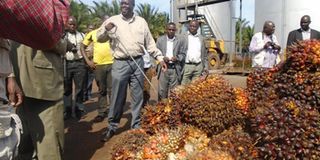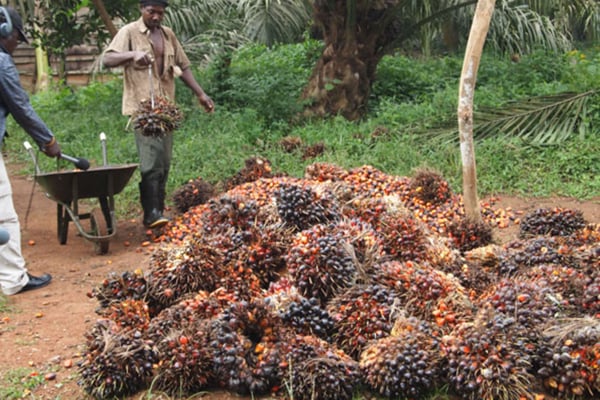Farmers fault govt over oil palm project

Demonstration. Kalangala Oil Palm Growers Trust general manager Nelson Basaalidde (centre) demonstrates how oil palm is cultivated at the BIDCO factories in Kalangala recently. Government has earmarked Shs720b for the expansion of oil palm project in the country. FILE PHOTO
What you need to know:
- Mr Diamond Cancoo, the chairperson of the oil palm farmers, said the government had initially committed to making 40,000 hectares available for planting oil palm trees.
Oil palm farmers in Kalangala District, operating under the Ssese Oil Palm Growers Comparative Society Limited (SOPAGCO), have criticised the government for its failure to secure the required acreage of land for oil palm production, 18 years after the crop’s introduction.
Mr Diamond Cancoo, the chairperson of the oil palm farmers, said the government had initially committed to making 40,000 hectares available for planting oil palm trees. However, less than half of the promised land has been provided so far.
“We urge the government to fulfill its commitment so that this sub-sector can thrive as initially envisioned. The demand for oil palm is steadily increasing, but production remains low,’’Mr Cancoo said in an interview yesterday.
Presently, Uganda produces only 80,000 metric tonnes of edible oil, falling short of more than 40,000 metric tonnes.
Statistics from the Agriculture ministry reveal that the government has secured only 12,000 hectares in Kalangala District, 5,000 hectares in Buvuma, and 8,000 hectares in Masaka District.
Of the 12,000 hectares in Kalangala, 6,500 are allocated to the investor, Oil Palm Uganda Limited (OPUL), which was promised 25,000 hectares to establish a nucleus estate, a mill, and a nursery to support outgrower farmers with oil palm seedlings.
Mr Salidin Daminic, the general manager for OPUL, expressed concerns over the lack of additional land for expansion in Kalangala. He noted that the land secured in Masaka District, is yet to be utilised.
“We plan to replant 500 hectares of the existing old oil palm trees starting in 2027 until all 6,500 hectares are replanted. This process is expected to last until 2035,’’ he explained.
Parliament efforts
During a recent meeting with oil palm growers, legislators from the Committee on Agriculture, Animal Industry and Fisheries echoed similar concerns, urging the government to provide the necessary land for expanding oil palm production nationwide.
Mr Andrew Ojok Oulanyah, the Omoro County legislator and committee member, urged the government to scale up the oil palm project to more districts to boost production and ensure broader benefits.
Mr Fred Kyakulaga, the State minister for Agriculture, said the ministry aims to plant more than 100,000 hectares of oil palm by 2025, aiming for 100 percent local production of vegetable oil.
“Oil palm production currently contributes only 10 percent of the vegetable oil needed locally. This has led to the government spending $300 million on importing crude oil. We aim to reverse this and achieve 100 percent production by 2025,’’ he said.
While 11,800 hectares of oil palm trees have been planted on Kalangala’s main island of Buggala, expansion efforts to other islands like Bunyama and Bubembe face challenges due to inaccessibility and high costs of seedlings.




